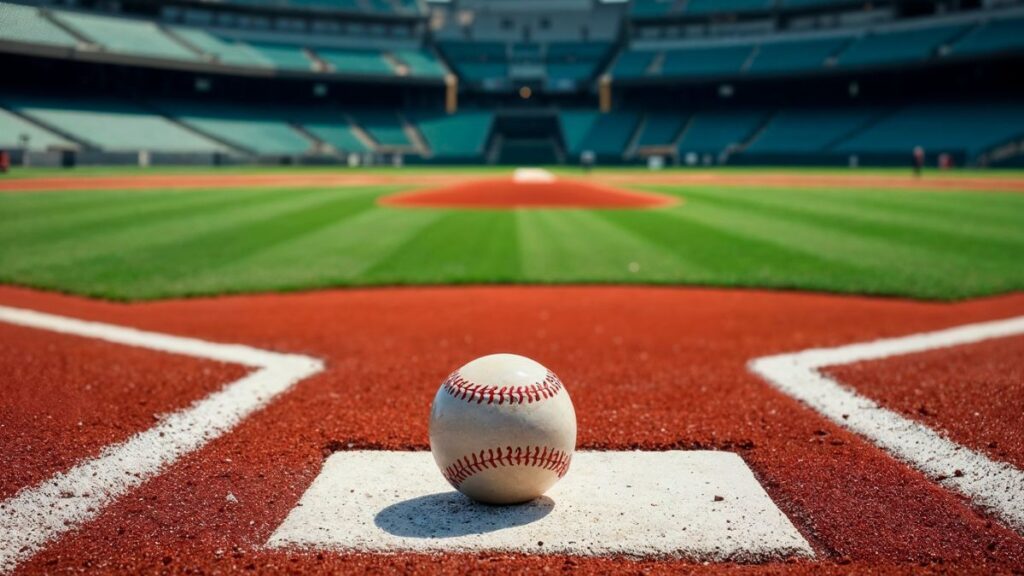Good softball field lights keep games going after dark. They help players see the ball clearly. They make fields safer for everyone. Quality lighting lets teams practice longer. It brings communities together for evening games.
Proper lighting does more than just brighten fields. It creates safe spaces for players. It makes games more fun to watch. Fields with good lights get used more often. This means more games and more fun for everyone.
Understanding Softball Field Lighting Basics
Softball field lights need to light up the whole field evenly. They cover the infield and outfield. They also light up areas where fans sit. These lights are different from regular outdoor lights. They have special features for sports.
The lights go on tall poles around the field. Each pole has several light fixtures. The poles are placed in specific spots. This helps avoid shadows on the field. Players can see the ball better this way.
Good lighting systems use new technology. LED lights are very popular now. They turn on right away. They last longer than old lights. They also use less electricity. This saves money over time.
Types of Softball Field Lights
LED Softball Field Lights
LED lights are the best choice for most fields. They turn on instantly. No waiting for them to warm up. The light looks like natural daylight. This helps players see colors better.
LED softball field lights last a very long time. They can work for over 50,000 hours. They handle weather well. Rain and wind don’t hurt them. They rarely break down. This means less fixing and replacing.
You can dim LED lights when needed. This saves energy during practice. It also helps control how much light spills into nearby areas. Many facilities love this feature.
Metal Halide Lighting Systems
Metal halide lights are older technology. They still work well for many fields. They give off good light quality. The colors look natural under these lights. But they have some problems.
These lights need time to warm up. They can’t turn on instantly. They use more electricity than LED lights. They also need new bulbs more often. The bulbs get weaker as they age.
Some fields still use metal halide lights. They cost less to buy at first. But they cost more to run over time. Most new fields choose LED instead.
High-Pressure Sodium Options
High-pressure sodium lights give off yellow light. This makes colors look different. They’re not great for competitive games. But they work okay for casual play.
These lights last longer than metal halide. They use less electricity too. But the yellow light is their biggest problem. Players have trouble seeing some colors. This can affect their performance.
Most fields avoid these lights now. LED and metal halide work better for softball. The yellow light just isn’t good enough for most games.
Key Features to Consider
Light Distribution and Uniformity
The best softball field lights spread light evenly. Every part of the field gets the same amount of light. This prevents dark spots and shadows. Players can see clearly everywhere.
Good lights use special reflectors. These direct light exactly where it’s needed. The light stays on the field. It doesn’t waste energy lighting empty areas.
Professional designers use computer programs. They plan where each light goes. This creates the best lighting pattern. It also uses the fewest lights possible.
Color Temperature and Rendering
Color temperature affects how things look. Good softball field lights use white light. This makes colors look natural. Players can see the ball better. Uniforms look the right colors.
LED lights keep the same color throughout their life. Old lights change color as they age. This makes games look different over time. LED lights stay consistent.
The best lights have high color rendering. This means colors look very natural. Red dirt looks red. Green grass looks green. This helps players and fans enjoy games more.
Glare Control and Light Pollution
Good lights don’t create glare. Glare hurts players’ eyes. It makes it hard to see the ball. It also bothers people in nearby houses. Quality lights control where light goes.
Modern lights have special shields. These keep light on the field. They stop light from going up into the sky. This prevents light pollution. It also saves energy.
Some lights can be adjusted after installation. This helps fix any glare problems. It also lets you change lighting if needed. This flexibility is very helpful.
Installation Requirements
Pole Placement and Height
Light poles need to be in the right spots. Most fields use four to six poles. They go around the outside of the field. The poles are usually 60 to 80 feet tall.
The poles can’t be too close together. But they can’t be too far apart either. The right spacing gives even light coverage. It also uses fewer lights.
Professional installers know the best pole positions. They use special software to plan this. This makes sure every part of the field gets good light.
Electrical Infrastructure
Softball field lights need a lot of electricity. The electrical system must be strong enough. It needs proper grounding for safety. It also needs surge protection.
Many systems have timers and controls. These turn lights on and off automatically. Some have remote controls too. This makes managing the lights easier.
The electrical work must follow local codes. Only licensed electricians should do this work. They know the safety requirements. They also know the right materials to use.
Permits and Regulations
Most places require permits for sports lighting. You need to apply before starting work. The city or county will review your plans. They want to make sure the lights are safe.
Some areas have rules about light levels. They don’t want lights too bright. They also have rules about operating hours. These protect nearby residents.
Working with experienced contractors helps. They know the local rules. They can help get permits approved faster. They also know how to design lights that meet all requirements.
Energy Efficiency and Costs
Operating Costs and Energy Consumption
Softball field lights use a lot of electricity. A typical field might use 20,000 to 40,000 watts. This can cost hundreds of dollars per month. LED lights can cut this cost in half.
Many electric companies offer rebates for LED lights. These rebates can pay for part of the installation. Some utilities also have special rates for sports facilities.
Energy costs keep going up. Efficient lights save more money each year. This makes LED lights a smart long-term choice. The savings add up quickly.
Maintenance and Replacement Costs
Old lights need frequent maintenance. Bulbs burn out regularly. Ballasts fail often. Getting to lights on tall poles is expensive. Workers need special equipment.
LED lights need much less maintenance. They last 3-5 times longer than old lights. When they do need service, it’s usually simple. Many parts are covered by long warranties.
The labor cost for maintenance is often higher than parts. LED lights reduce both costs. This saves money every year. It also means less disruption to games.
Long-term Value and Return on Investment
LED lights cost more upfront. But they save money over time. Energy savings alone often pay for the lights. Lower maintenance costs add even more savings.
Better lighting can increase field usage. More teams want to play on well-lit fields. This can bring in more rental income. It also makes the facility more valuable.
Most LED installations pay for themselves in 3-5 years. After that, all the savings go to the bottom line. This makes LED lights a smart investment.
Safety and Performance Benefits
Player Safety Enhancement
Good lighting prevents injuries. Players can see the ball clearly. They can avoid collisions with other players. They can see field conditions better too.
LED lights turn on instantly. This is important for emergencies. If regular lights fail, backup lights work right away. This keeps everyone safe.
Even lighting prevents dangerous shadows. Players won’t lose sight of the ball. This reduces the chance of getting hit. It also prevents falls and other accidents.
Improved Game Performance
Better lighting helps players perform better. Batters can see pitches more clearly. Fielders can track fly balls easier. Catchers can see signals better.
Good color rendering helps too. Players can see spin on the ball. They can judge distances better. This leads to better plays and more exciting games.
Consistent lighting throughout the game is important. Old lights get dimmer as they heat up. LED lights stay bright all game long. This keeps performance consistent.
Spectator Experience
Fans enjoy games more under good lighting. They can see all the action clearly. They can follow the ball throughout the game. This makes games more exciting to watch.
Good lighting makes fields look professional. This attracts more fans. It also makes the facility a source of community pride. People want to come to well-maintained facilities.
Safety is important for spectators too. Good lighting helps them move around safely. They can see steps and walkways. This prevents accidents and injuries.
Maintenance and Longevity
Routine Maintenance Requirements
All lights need regular cleaning. Dirt and bugs reduce light output. Cleaning should happen several times per year. This keeps lights working at full brightness.
Electrical connections need checking too. Loose connections cause problems. They can also be dangerous. Regular inspections prevent these issues.
LED lights need less maintenance overall. But they still need some care. Following the manufacturer’s recommendations helps lights last longer. It also keeps warranties valid.
Troubleshooting Common Issues
Lights sometimes flicker or go out. This can be caused by several things. Loose connections are common. Bad bulbs or drivers can cause problems too.
Having spare parts helps fix problems quickly. Basic tools and supplies should be on hand. This reduces downtime when issues occur.
Some problems need professional help. Electrical issues can be dangerous. Complex control systems may need expert service. Don’t try to fix everything yourself.
Upgrading and Modernization
Many old lighting systems can be upgraded. New LED lights often fit existing poles. This saves money on installation. It also reduces construction disruption.
Smart controls can be added to most systems. These make lights easier to manage. They also provide better energy control. This adds value to any upgrade.
Planning upgrades carefully is important. Consider future needs too. Technology keeps improving. Leave room for future enhancements.
Environmental Impact
Energy Conservation Benefits
LED lights use much less electricity. This reduces pollution from power plants. It also reduces strain on the electrical grid. Every bit of energy saved helps the environment.
LED lights last much longer. This means less waste in landfills. It also means less manufacturing pollution. The environmental benefits add up over time.
Many LED lights can be recycled. The materials have value. This reduces waste even more. It also supports the circular economy.
Light Pollution Reduction
Good lighting design reduces light pollution. Light stays on the field where it’s needed. It doesn’t shine into the sky. This protects dark skies for astronomy.
Wildlife benefits from better lighting too. Excessive light can hurt animals. Proper lighting reduces these impacts. It helps maintain natural ecosystems.
Communities appreciate reduced light pollution. It’s less disruptive to nearby residents. It also reduces complaints about the facility. This builds better community relationships.
Sustainable Lighting Solutions
Many manufacturers focus on sustainability. They use recycled materials. They also use renewable energy in production. This makes the lights more environmentally friendly.
Some companies offer take-back programs. They’ll recycle old lights when you upgrade. This ensures proper disposal. It also supports environmental goals.
Choosing sustainable products sends a message. It shows the community cares about the environment. This can inspire others to make better choices too.
Future Trends
Smart Lighting Technologies
New lights can connect to the internet. This allows remote control and monitoring. Facility managers can control lights from anywhere. They can also get alerts about problems.
Smart lights can adjust automatically. They can respond to weather conditions. They can dim when no one is around. This saves energy and money.
Data from smart lights helps with planning. It shows usage patterns. It also tracks energy consumption. This information helps make better decisions.
Integration with Smart Facilities
Lights can work with other systems. They can connect to security systems. They can work with irrigation controls. This creates a unified management system.
Mobile apps make control easier. Facility managers can use their phones. They can adjust lights from anywhere. This makes management more convenient.
Integration saves time and money. One system can control everything. This reduces complexity. It also reduces training requirements.
Advanced Control Systems
New control systems are very sophisticated. They can create different lighting scenes. They can adjust for different sports. They can even optimize for TV broadcasts.
Voice control is becoming popular. Facility managers can use voice commands. This makes operation even easier. It also reduces the need for complex interfaces.
Future systems will be even smarter. They’ll learn from usage patterns. They’ll optimize automatically. This will make facility management almost effortless.
Conclusion
Quality softball field lights make a huge difference. They improve safety for players. They make games more enjoyable. They help facilities get more use.
LED lights are the best choice for most fields. They save energy and money. They last longer than old lights. They also provide better light quality.
Good lighting is an investment in the community. It brings people together. It supports youth sports. It creates lasting memories.
Choose your lights carefully. Work with experienced professionals. Plan for the future. Your community will benefit for years to come.
The right softball field lights transform ordinary fields. They create spaces where champions are made. They ensure the game can always go on.







